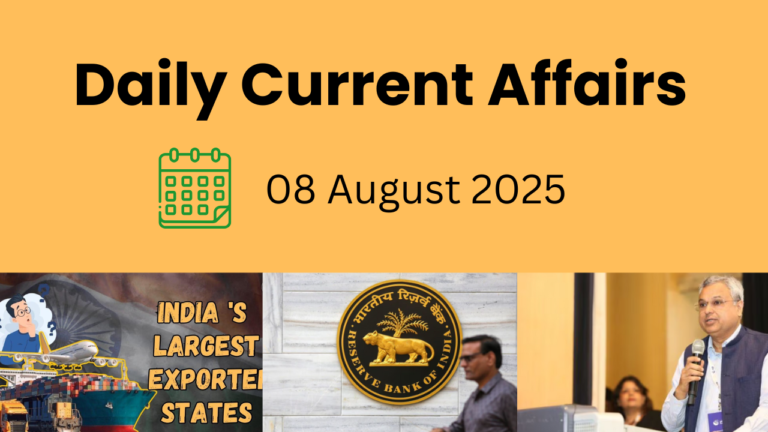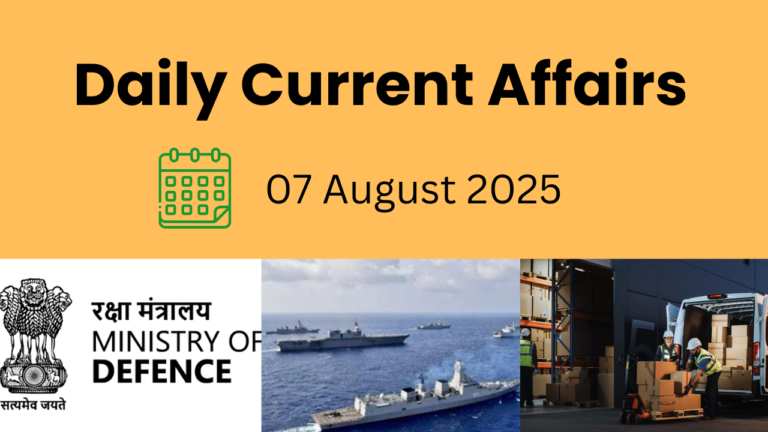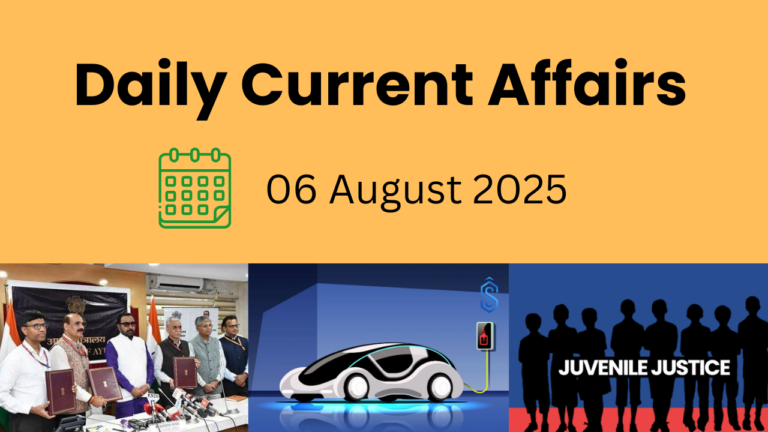1. RBI’s FREE-AI Committee: A Step Towards Ethical AI in Finance
Context: The Reserve Bank of India (RBI) has established a specialized committee named FREE-AI to develop a comprehensive framework for the responsible and ethical implementation of Artificial Intelligence (AI) in the financial sector.
What is the FREE-AI Committee?
The FREE-AI Committee is an eight-member panel tasked with creating guidelines for the ethical and responsible adoption of AI within financial services.
Key Highlights:
- Leadership: The committee is chaired by Pushpak Bhattacharyya, Professor at the Department of Computer Science and Engineering, IIT Bombay.
- Members:
- Representatives from NITI Aayog
- Experts from HDFC Bank and IIT Madras
- Officials from the Ministry of Electronics and Information Technology
- Specialists from law firm Trilegal and Microsoft India
- Support: Backed by the RBI’s Fintech Department.
- Timeline: The committee is required to submit its report within six months from its first meeting.
Objectives of the Committee:
- Assess AI Adoption:
- Evaluate the current level of AI adoption in India’s financial services sector.
- Study the global regulatory and supervisory approaches to AI, particularly in financial systems.
- Create an Ethical Framework:
- Propose a framework to ensure responsible and ethical use of AI models in the financial domain.
- Focus on governance aspects to prevent misuse and maintain transparency.
- Risk Identification and Mitigation:
- Identify potential risks and challenges associated with AI in financial services.
- Recommend strategies for evaluation, mitigation, and monitoring of these risks by regulated entities.
Significance of the FREE-AI Initiative:
- Boosting Trust in AI Systems: Developing a governance framework will help build public confidence in AI-driven financial systems.
- Enhancing Regulatory Preparedness: The recommendations will enable the RBI to stay ahead of emerging risks and guide financial institutions in adopting AI responsibly.
- Fostering Innovation with Responsibility: The initiative ensures that while financial institutions leverage AI for innovation, it is done in a manner that is transparent, ethical, and safe.
Conclusion: The FREE-AI Committee represents a forward-looking approach by the RBI to embrace AI in the financial sector while ensuring its responsible and ethical implementation. By balancing innovation with governance, this initiative is set to redefine the future of AI in India’s financial ecosystem.
2. Exercise SURYA KIRAN: Strengthening India-Nepal Military Bonds
Context: The 17th edition of the joint military exercise SURYA KIRAN is scheduled to take place in Pithoragarh, Uttarakhand, from 24th November to 7th December 2023. This collaborative drill aims to strengthen the longstanding military cooperation between India and Nepal.
What is Exercise SURYA KIRAN?
A Bilateral Initiative:
- SURYA KIRAN is a joint military exercise conducted annually between the Indian Army and the Nepal Army.
- The exercise is conducted alternately in both countries, fostering a spirit of collaboration and camaraderie.
Objectives:
- Enhance Interoperability: Focuses on conducting operations such as jungle warfare, counter-terrorism in mountainous terrains, and humanitarian assistance under the United Nations Charter.
- Operational Skill Development: Through diverse war games, both forces refine their combat skills, share best practices, and improve coordination.
- Knowledge Exchange: Provides a platform for soldiers to share experiences, learn from each other, and align their operational strategies.
17th Edition Highlights:
- Location: Pithoragarh, Uttarakhand, India.
- Focus Areas: Jungle warfare, counter-terrorism, and disaster relief.
- Strengthens the historical and military bonds between India and Nepal.
Looking Ahead: 18th Edition:
Venue and Leadership:
- Location: Saljhandi, Nepal.
- Indian Contingent: Represented by a battalion of the 11th Gorkha Rifles.
- Nepalese Contingent: Represented by the Srijung Battalion.
Significance:
The upcoming edition aims to further solidify the cooperation between the two nations and enhance their readiness for challenging scenarios.
Conclusion:
Exercise SURYA KIRAN symbolizes the strong military partnership and shared commitment between India and Nepal to regional security and humanitarian efforts. With its focus on skill-building and mutual understanding, the exercise continues to serve as a cornerstone of bilateral defense cooperation.
3. GPS Spoofing: A Growing Threat to Navigation and Security
Context: Instances of GPS interference, including the use of spoofing techniques that transmit false signals, are increasingly reported near conflict zones worldwide. Notably, such occurrences have also been detected along India’s borders with Pakistan, raising alarms about the security and reliability of GPS-based systems.
What is GPS Spoofing?
Definition:
- GPS Spoofing (also called GPS simulation) is a cyberattack technique that manipulates GPS receivers by broadcasting fake GPS signals.
- The result? Devices are misled into detecting an incorrect location, undermining the reliability of GPS-based navigation and data.
Impact:
GPS spoofing poses serious risks, from disrupting navigation systems to compromising time synchronization—critical for aviation, shipping, military, and civilian applications.
How Does GPS Spoofing Work?
- Exploitation of Weak Signals:
- GPS signals transmitted by satellites to Earth are inherently weak.
- Spoofers exploit this vulnerability by overwhelming the genuine signals with stronger, counterfeit signals.
- The Attack Process:
- The attacker studies the target’s GPS setup, understanding the signals it uses and how they are processed.
- Counterfeit signals, designed to mimic authentic GPS signals, are broadcast at higher strength.
- Result: The receiver prioritizes the fake signals, causing it to calculate an incorrect location.
Why is GPS Spoofing a Concern?
- Navigation Failures: Misleading location data can disrupt aircraft, ships, and ground transport, jeopardizing safety.
- Military Implications: Spoofing can mislead drones, missiles, or other GPS-reliant military technologies.
- Economic Impact: Industries relying on GPS for logistics and operations face significant disruptions.
- Security Risks: Spoofing in conflict zones can escalate tensions or hinder responses to emergencies.
Conclusion:
The rising cases of GPS spoofing highlight the need for enhanced cybersecurity measures and robust GPS signal verification systems. As the technology underpinning global navigation becomes more critical, protecting it from manipulation will be paramount to ensuring safety, security, and reliability in an interconnected world.
4. Lothal: A Global Beacon of Maritime Heritage
Context: Lothal, an ancient gem of the Indus Valley Civilization, is set to emerge as a global hub for maritime heritage with the creation of the National Maritime Heritage Complex (NMHC) in Gujarat.
This visionary project, led by the Ministry of Ports, Shipping, and Waterways under the Sagarmala Programme, aims to celebrate India’s rich maritime past while driving economic and cultural progress.
The Historical Brilliance of Lothal:
Maritime Excellence of the Past:
- Dating back to 2400 BCE, Lothal was a thriving center of the Harappan Civilization.
- Famous for its advanced dockyard, extensive trade networks, and expertise in bead-making, Lothal showcased exceptional craftsmanship and strategic acumen.
- Artefacts such as seals, tools, and pottery reveal a flourishing cultural and economic ecosystem.
A Trade Powerhouse:
- Lothal was not just a city but a strategic maritime hub, connecting regions through its efficient maritime infrastructure.
National Maritime Heritage Complex (NMHC):
A Visionary Initiative:
The NMHC is designed as a world-class facility that blends education, tourism, and cultural preservation.
Key Features:
- Interactive “Edutainment” Experience: Engages visitors through a unique blend of education and entertainment, showcasing maritime history from the ancient Harappan era to the modern age.
- Advanced Infrastructure:
- Lothal Jetty Walkway: A landmark attraction.
- Museum Block: To house priceless artefacts and stories of India’s maritime journey.
- INS Nishank: A decommissioned warship, symbolizing India’s naval prowess.
Progress So Far:
- Over 65% of construction is complete.
Socio-Economic Impact:
- Tourism Boom: Expected to draw domestic and international visitors.
- Employment Opportunities: Creating jobs and empowering local youth through skill development programs.
- Global Maritime Education: A platform for learning and collaboration in the global maritime community.
Government Efforts and Collaboration:
Sagarmala Programme:
- A flagship initiative to modernize India’s maritime infrastructure and drive port-led economic growth.
Collaborative Approach:
- Partnerships with the Ministry of Defence, Indian Navy, Coast Guard, and the Government of Gujarat ensure a high-quality and inclusive development process.
Community Involvement:
- Actively includes local communities, fostering a sense of ownership and shared progress.
Why Lothal Matters:
Tourism and Learning:
- The NMHC will position Lothal as a global hub for maritime education and tourism, preserving India’s maritime legacy.
Economic Growth:
- Contributing to India’s global presence by boosting economic and cultural advancements.
International Collaboration:
- Serves as a bridge between India’s maritime industry and the global maritime sector, opening avenues for partnerships and knowledge exchange.
Conclusion:
The National Maritime Heritage Complex at Lothal is more than a tribute to India’s rich maritime heritage—it’s a bold step toward integrating history with economic, educational, and cultural progress.
This project not only honors Lothal’s legacy but also reaffirms India’s ambition to become a global leader in maritime excellence.
5. Navigating India’s Foreign Policy Maze in 2025
Context: Following the start of Prime Minister Modi’s third term in June 2024, India’s foreign policy witnessed intense activity amidst a backdrop of global insecurity and regional tensions, particularly in Bangladesh.
With 2025 expected to bring even more unpredictability, India’s diplomacy must remain agile to navigate emerging challenges effectively.
Key Milestones in India’s External Relations:
India-China Relations: A Step Forward:
- The disengagement at the Line of Actual Control (LAC) with China was one of 2024’s most sensitive negotiations.
- A significant breakthrough came during the Modi-Xi Jinping meeting at the BRICS Summit in Russia—their first interaction in five years.
Deepening Ties with France:
- French President Emmanuel Macron graced India’s Republic Day celebrations, underscoring growing cooperation in defense, energy, and maritime sectors.
- Although efforts to host U.S. President Biden for the Quad Summit did not materialize, Macron’s visit reinforced the reliability of bilateral ties.
Progress on Trade Agreements:
- The India-European Free Trade Association (EFTA) Agreement, finalized in early 2024, set a precedent for future free trade agreements (FTAs).
- However, progress on deals with Australia, the U.K., and the EU remained stalled by year-end.
Diplomatic Engagements in the Neighborhood:
- PM Modi’s swearing-in ceremony saw the participation of leaders from most neighboring countries, except Pakistan.
- Relations improved with Sri Lanka, Maldives, and Bhutan, marked by high-profile exchanges and diplomatic visits.
Challenges that Dominated 2024:
Strained Ties with Bangladesh:
- The removal of Prime Minister Sheikh Hasina in August triggered a diplomatic rift.
- Rising attacks on Hindu minorities and Hasina’s subsequent stay in India added to tensions.
Deteriorating Relations with Canada:
- Allegations of India’s involvement in the killing of Hardeep Singh Nijjar led to a diplomatic freeze.
- Home Minister Amit Shah’s alleged involvement further strained ties, with India awaiting potential political changes in Canada in 2025.
Legal and Diplomatic Tensions with the U.S.:
- Accusations against the Adani Group and India’s alleged link to the Pannun assassination plot strained India-U.S. relations.
- However, the election of President Donald Trump, known for his pro-India stance, offers hope for a reset in bilateral ties.
China’s Expanding Influence in South Asia:
- China’s growing footprint in Nepal and its engagement with Bangladesh continue to challenge India’s strategic interests in the region.
How India Managed Global Conflicts:
Neutrality in Global Conflicts:
- India advocated for peace while staying neutral during the Russia-Ukraine war and Israel-Gaza conflict.
- PM Modi’s visits to Russia and Ukraine fueled speculation about India’s potential role as a mediator.
- While condemning civilian casualties in Gaza, India refrained from explicitly holding Israel accountable at the UN.
Shifting Focus in West Asia:
- With initiatives like IMEC and I2U2 facing hurdles, India turned to bilateral engagements with West Asian countries.
- Managing tensions between Iran and the Israel-U.S. alliance will be a priority in 2025.
The Diplomatic Roadmap for 2025:
Strengthening India-U.S. Ties:
- External Affairs Minister Jaishankar’s engagement with the Trump transition team signals a strong focus on the U.S. in 2025.
- Key highlights include President Trump’s visit for the Quad Summit and a potential PM Modi trip to Washington.
Focus on Iran and Emerging Technologies:
- Early 2025 will see a high-level visit from Iran, followed by U.S. NSA Jake Sullivan’s trip for discussions on critical and emerging technologies (iCET).
High-Profile Visits:
- Indonesian President Prabowo Subianto will be the chief guest for Republic Day, while Russian President Vladimir Putin is expected to visit India for the first time since the war began.
Conclusion:
India’s foreign policy in 2025 must be prepared to adapt to dynamic global and regional developments. By balancing relations with major powers, addressing neighborhood challenges, and leveraging strategic opportunities, India aims to cement its position as a key player on the global stage.
6. The South Asian Economic Union: A Vision for Regional Prosperity
Context: The South Asian Economic Union (SAEU) remains a long-term ambition in the face of complex geopolitical and economic challenges within the region. Despite its aspirational status, the SAEU presents a potential path to enhanced economic cooperation across the South Asian region.
What is the South Asian Economic Union?
Definition:
The South Asian Economic Union is a vision of the South Asian Association for Regional Cooperation (SAARC) aimed at integrating the economies of its eight member states: Afghanistan, Bangladesh, Bhutan, India, Maldives, Nepal, Pakistan, and Sri Lanka.
Objective:
The primary goal of the SAEU is to foster regional trade, investment, connectivity, and economic cooperation through a phased integration of markets across the member countries.
Foundation:
The SAEU builds upon existing frameworks like SAFTA (South Asian Free Trade Area), established in 2006, which works towards reducing tariffs and promoting free trade among the nations.
Pillars of Integration:
The key pillars for regional integration include:
- Market integration
- Cross-border connectivity
- Energy cooperation
- Private sector liberalization (according to an ADB Report)
Trade Dynamics Among SAARC Members:
Current State of Trade:
- Intra-regional trade remains low, accounting for less than 5% of formal trade among SAARC nations.
- India’s dominance: India contributes 73% of intra-regional exports, but imports only 13%, creating significant trade imbalances.
Trade Imbalances:
- Smaller nations like Bhutan, Afghanistan, and Nepal heavily depend on intra-regional exports, with shares of 82%, 67%, and 71%, respectively.
- Trade barriers, including non-tariff barriers (NTBs) and safeguard measures, continue to hinder effective trade liberalization under SAFTA.
The Role of Regional Partnerships in Economic Integration:
BIMSTEC’s Role:
- BIMSTEC (Bay of Bengal Initiative for Multi-Sectoral Technical and Economic Cooperation) plays a key role in promoting regional connectivity and economic cooperation.
- BIMSTEC serves as a bridge between South Asia and Southeast Asia, facilitating infrastructure projects like the BIMSTEC Master Plan for Transport Connectivity.
- The initiative enhances cooperation in sectors like energy, tourism, and technology, strengthening regional economic integration.
SAARC’s Contribution:
- SAARC’s establishment of the South Asian Free Trade Area (SAFTA) is pivotal in reducing tariffs and promoting intra-regional trade, laying the groundwork for deeper economic integration.
- Policy harmonization across member states is crucial to creating a unified regional market, enabling smoother economic cooperation.
India’s Initiatives to Enhance Regional Economic Cooperation:
- Neighbourhood First Policy: India’s Neighbourhood First Policy emphasizes strengthening ties with SAARC nations through both bilateral and multilateral agreements, aiming to enhance regional economic stability.
- Key India-Sri Lanka Initiatives: Expansion of the India-Sri Lanka Free Trade Agreement and development of Trincomalee as a potential energy hub are key components of regional cooperation.
- Energy Connectivity: Projects like the Bangladesh-Bhutan-India-Nepal (BBIN) energy grid are vital to enhancing regional power trade and boosting energy cooperation across borders.
- Infrastructure and Digital Connectivity:
- Infrastructure projects such as the Kaladan Multimodal Transit Transport Project and improved road corridors with Myanmar and Bangladesh are essential for improving trade routes.
- India’s push for digital connectivity and e-governance in neighboring countries also facilitates smoother trade and investment flows.
Challenges to the South Asian Economic Union:
- Political Tensions: India-Pakistan relations remain a core issue, while Nepal’s involvement with China’s Belt and Road Initiative adds another layer of complexity to regional dynamics.
- Trade Imbalances: India’s export dominance and limited imports from other SAARC nations create economic disparities, which could undermine the goal of regional integration.
- Non-Tariff Barriers: Restrictive trade policies and the absence of harmonized trade regulations remain obstacles to effective liberalization and regional economic growth.
- Infrastructure Gaps: Poor transport and logistics infrastructure hinder effective cross-border trade, necessitating significant investment in connectivity projects.
- Economic Disparity: Diverging economic policies and varying development levels among SAARC members complicate efforts towards seamless integration.
The Road Ahead for the South Asian Economic Union:
- Strengthening SAFTA: To boost regional trade, there is a need to revise and simplify trade agreements, eliminate non-tariff barriers, and encourage fair trade practices.
- Boosting Connectivity: Key investments in transport corridors, energy grids, and digital infrastructure are essential to facilitate smoother trade flows and economic cooperation.
- Addressing Political Issues: Resolving political tensions through multilateral dialogues and fostering mutual trust among SAARC nations will be vital for integration.
- Leveraging the Private Sector: Encouraging private sector involvement in regional projects will drive innovation and facilitate investment in integration efforts.
- Promoting Inclusivity: Ensuring equitable policies to balance the economic disparity between larger and smaller nations will be key to ensuring that all countries benefit from integration.
Conclusion: A Vision for the Future
The creation of a South Asian Economic Union holds immense potential to transform the region’s economic landscape, but achieving this vision will require overcoming longstanding political, economic, and infrastructural challenges. Through continued efforts, cooperation, and strategic initiatives, the dream of a unified South Asia could become a reality, leading to a more prosperous and interconnected region.




